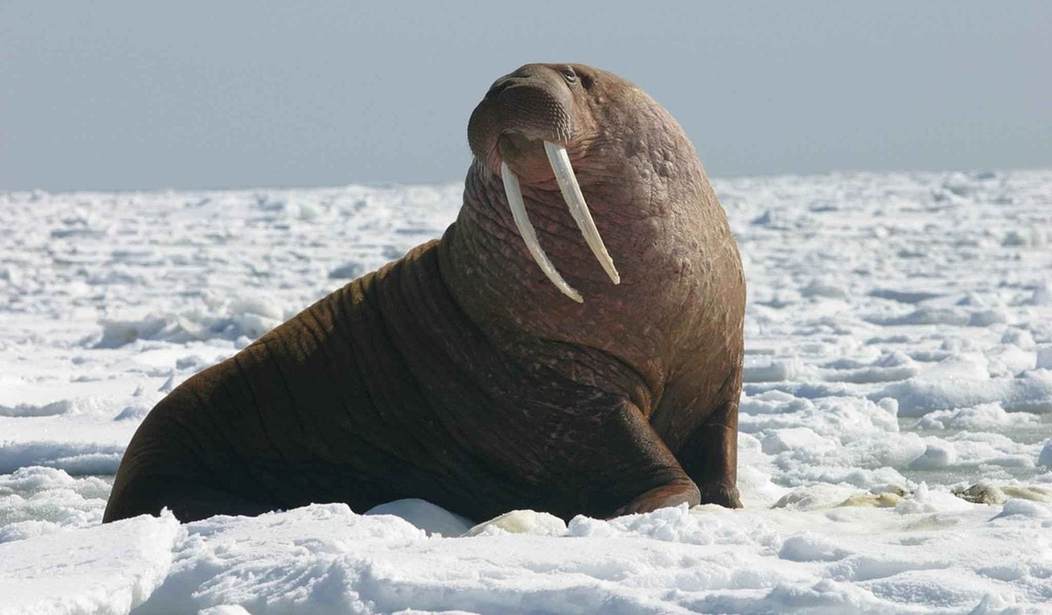The U.S. Fish and Wildlife Service regularly considers adding animals that are considered to be especially vulnerable to extinction to the endangered species list, and many ecologists are upset that 25 American creatures, particularly the Pacific walrus, didn’t make the cut this year.
SHOCKING: @realDonaldTrump gives Pacific walrus 'death sentence' as administration fails to list them as endangered.https://t.co/udrGoRsjsP pic.twitter.com/sOqCPV4Hon
— Labour Animal Rights Group (@LabourAnimalRG) October 8, 2017
According to the USFWS, giving these animals the additional protections of being an endangered species “is not warranted at this time.” The USFWS explained its decision regarding the stability of the walrus population in a press release:
While walruses use sea ice for a variety of activities, including breeding, birthing, resting, and avoiding predators, they have shown an ability to adapt to sea ice loss that was not foreseen when the Service last assessed the species in 2011. Our decision not to list the Pacific walrus under the Endangered Species Act at this time is based on a rigorous evaluation of the best available science, which indicates the population appears stable, and the species has demonstrated an ability to adapt to changing conditions. If future circumstances warrant or new information comes to light, we can and will re-evaluate the Pacific walrus for ESA protection.
There are actually two subspecies of walrus. The Atlantic walrus is found throughout the shorelines of Greenland and northeastern Canada, and the Pacific walrus resides in the icy waters along Alaska and Russia. Walruses can weigh up to 1.5 tons, are protected from the frigid cold of the Arctic region with a thick layer of blubber, and survive on a diverse carnivorous diet of clams, shrimp, crabs, sea cucumbers, and other marine invertebrates. A walrus uses its famous ivory tusks as ice hooks to pull itself out of the water, and as defensive tools against the mammoth marine mammal’s only two natural predators: polar bears and killer whales.
America’s walruses are already protected under the Marine Mammal Protection Act, which prohibits the harvest, import, and export of the Pacific walrus or walrus products, although there are special exceptions for Alaska natives, who are allowed to hunt walruses for food and carve items from their tusks. They were pushed to be placed on the endangered species list during the Obama administration, but other threatened animals were of higher priority at the time, and walruses were placed on a list for future consideration. Regardless of the scientific findings of how the walrus population is both adaptable and beginning to stabilize, environmentalists are furious with this decision.
For instance, Noah Greenwald, the endangered species director at the Center for Biological Diversity, has strong feelings about the future of our native walruses:
This is a truly dark day for America’s imperiled wildlife. You couldn’t ask for a clearer sign that the Trump administration puts corporate profits ahead of protecting endangered species. The Pacific walrus, Florida Keys mole skink, eastern boreal toad and 22 other species are now one step closer to extinction. We’re going to challenge as many of these bogus findings as we can.”
The other 24 animals that were considered but not added to the endangered species list include 14 species of tiny snails native to Nevada, a cave-dwelling Floridian crawfish, the black-backed woodpecker, and a vividly colored mole skink that is exclusively found in the Florida Keys. Strangely enough, no one is writing news articles that praise the Trump administration for adding protections for 10 new species this year, such as Arizona’s rare Sonoyta mud turtle, Hawaii’s scarlet honeycreeper bird, and Mississippi’s Pearl darter fish.
Hawaii's scarlet honeycreeper, ʻiʻiwi, was once a common sight. Today, it lives primarily at higher elevations to avoid deadly mosquitos. pic.twitter.com/8adzX01ref
— NatureConservancyHI (@TNCHawaii) May 11, 2017
Even if the USFWS acknowledges that the walrus population seems to be approaching stability at a rate higher than what was recorded in the 1970s and 1980s with the science to back up that good news, you’ll still read exaggerated claims such as: “This disgraceful decision is a death sentence for the walrus.” This is likely because this decision was made under President Trump. If you thought that it was odd to see eco-groups so upset because walruses are doing well in the wild, it gets weirder: The Center for Biological Diversity has filed a lawsuit against the Trump administration for not listing the Pacific walrus as an endangered species.
Group plans to sue over walrus protection https://t.co/enu1ECbg74 pic.twitter.com/GLVUGFBis3
— Mercury News (@mercnews) October 13, 2017
The eco-group complains that the USFWS is ignoring “the best available science on climate change” and that it “… used an unlawfully short timeframe for its analysis of climate threats.” Kristen Monsell, the Center for Biological Diversity’s senior attorney, explains why she believes the lawsuit is necessary for the future of the species:
There’s no question Pacific walruses are endangered, so denying them protection is absurd and dangerous. The sea ice these animals need to survive is melting away. This ridiculous, about-face decision reflects the Trump administration’s hostility to wildlife, science, and the rule of law.
While the lawsuit could pull the president’s attention away from dealing with North Korea, a sweeping tax overhaul, and Puerto Rico’s ongoing recovery, I have a feeling that the perceived plight of the Pacific walrus might not be one of Trump’s highest priorities right now.









Join the conversation as a VIP Member